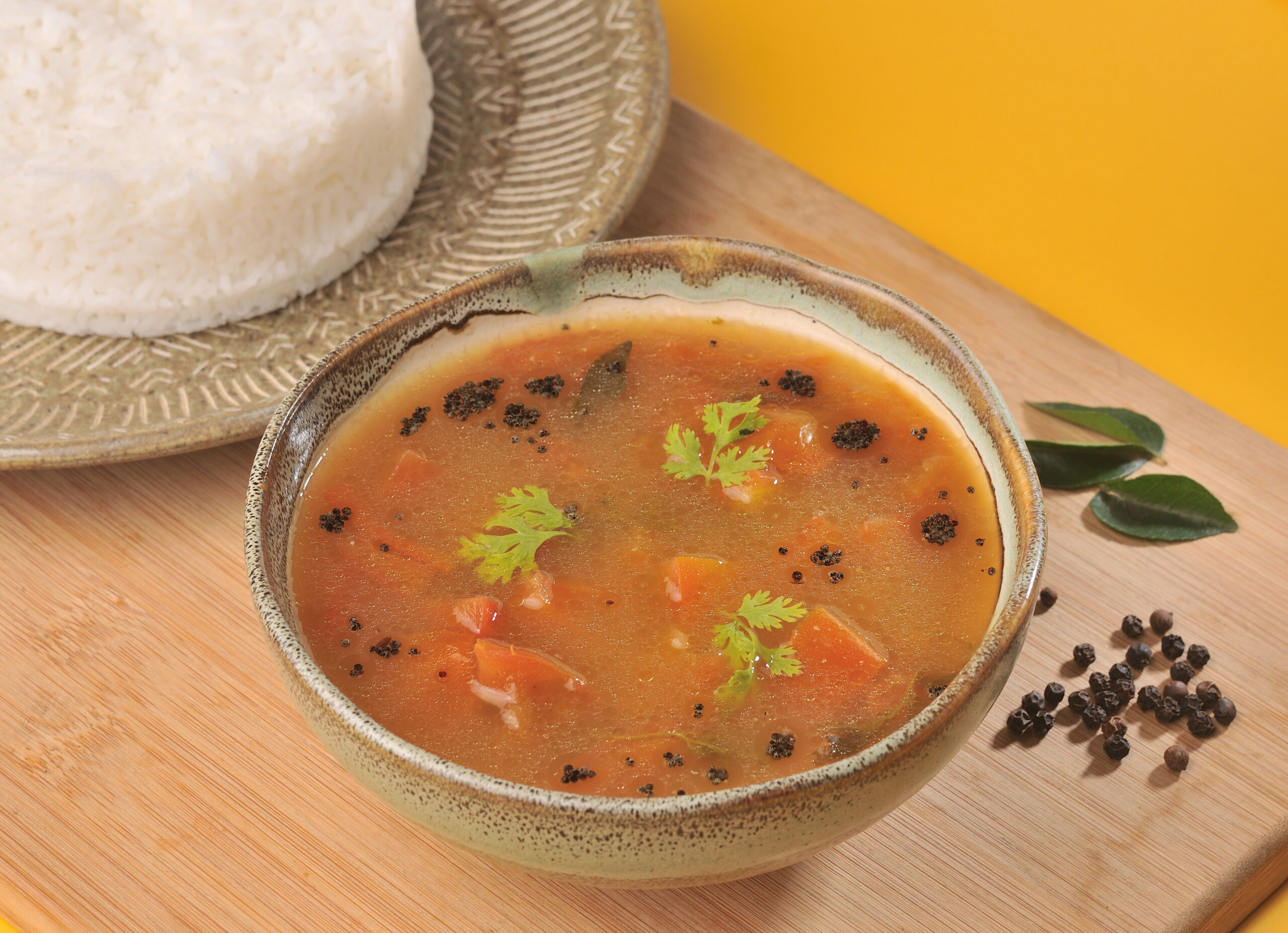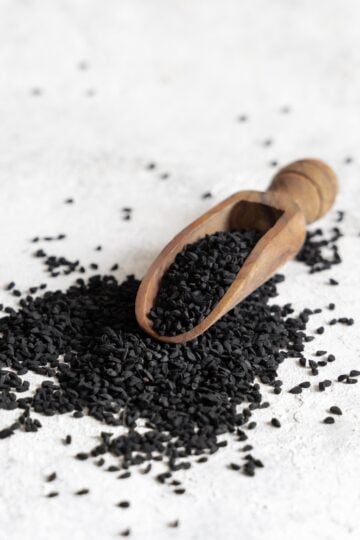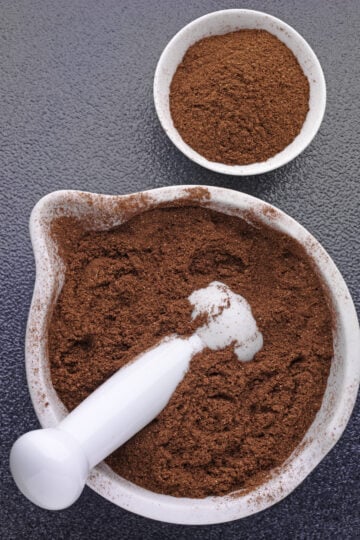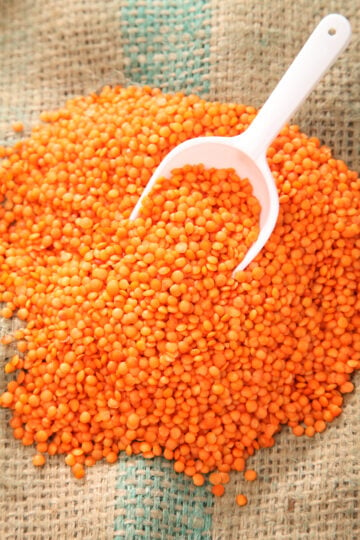
Rasam powder shows up in South Indian kitchens almost daily. The mix is simple, but when roasted right it brings heat from pepper, earthiness from cumin, and a clean, tangy depth to a light broth. It is practical everyday food, used not just for comfort but as a regular part of meals at home.
What Is Rasam Powder?
Rasam powder is a South Indian spice blend used to make rasam, a thin peppery broth served with rice or sipped on its own. It is usually made by dry-roasting and grinding black pepper, cumin, coriander seeds, dried red chilies, and toor dal. Curry leaves and asafoetida are often added for aroma. The mix creates a warm, tangy soup that is common across Tamil Nadu, Karnataka, Kerala and Andhra Pradesh, with each region adjusting heat and spice balance slightly in its own way.
- Main spices: Black pepper, cumin, coriander, dried red chilies, toor dal
- Common additions: Curry leaves, asafoetida, turmeric
- Used for: Rasam served with rice or as a light broth
- Flavor profile: Peppery, tangy, warm, aromatic
- Regional notes: Tamil versions lean peppery, Andhra hotter, Karnataka often milder
- Prep method: Spices dry-roasted then ground
- Best pairing: Steamed rice, ghee, simple vegetable sides
- Storage: Airtight jar, cool dry shelf to keep aroma
Key Ingredients and Their Roles
Each ingredient in rasam powder plays a unique part in shaping its aroma and balance.
-
Black pepper: The heart of the blend, adding gentle heat and depth.
-
Cumin seeds: Bring warmth and aid digestion.
-
Coriander seeds: Offer body and a mild earthiness.
-
Dried red chilies: Add color and a hint of spice.
-
Toor dal or chana dal: Provide texture and help the blend mix smoothly into the broth.
-
Fenugreek seeds: Add a subtle bitter note for balance.
-
Curry leaves: Lend freshness and aroma.
-
Asafoetida (hing): Enhances flavor and supports digestion.
The Roasting and Grinding Process
The making of rasam powder begins with slow roasting. Each spice; pepper, cumin, coriander, lentils, and curry leaves are toasted gently until aromatic. The heat must stay low, allowing every seed to release its natural oils without burning.
Once cooled, the mix is ground to a fine or coarse texture, depending on preference. When done right, it carries the aroma of warmth itself; light, sharp, and deeply comforting.
Flavor Profile
Rasam powder is light yet lively, marked by pepper’s warmth and cumin’s gentle calm. It awakens the senses without overpowering, leaving a clean, soothing finish that comforts with every sip.
Culinary Uses Across India and Beyond
In Tamil Nadu:
Rasam powder forms the base of classic milagu (pepper) rasam and garlic rasam, often paired with steamed rice or enjoyed as a light soup.
In Karnataka:
Used in saaru, a mellow version of rasam made with jaggery or coconut for balance, often served during daily meals.
In Andhra Pradesh and Telangana:
Spicier blends power tamarind-rich rasams, lending heat and body to the thin, tangy broth.
In Kerala:
Added to tomato or lemon rasam for a bright, restorative flavor, often part of traditional feasts.
Beyond India:
Chefs and home cooks use rasam powder to flavor soups, clear broths, and marinades, its peppery warmth adds instant comfort wherever it travels.

Flavor Pairings
-
Tamarind: Brings tang that balances the warmth of pepper and cumin.
-
Tomato: Adds freshness and light acidity.
-
Garlic: Deepens the broth with earthy aroma and body.
-
Curry leaves: Lift the blend with fragrance and herbal sweetness.
-
Mustard seeds: Give sharpness and texture when tempered in oil.
-
Ghee: Softens the spices and adds soothing richness.
-
Coriander leaves: Finish the dish with a burst of green freshness.
Together, they create a harmony of heat, tang, and calm, the true comfort of rasam.
Quick Tips to Get the Best Out of Rasam Powder
A few mindful steps can help you draw out the full aroma and comfort of rasam powder in every bowl.
-
Add at the right time: Stir in near the end of cooking to preserve its fresh aroma.
-
Simmer, don’t boil: Gentle heat helps the spices release flavor without turning bitter.
-
Bloom in ghee or oil: Briefly sauté before adding to rasam for a deeper, balanced aroma.
-
Use fresh tamarind water: It blends best with the spice mix, keeping the broth light and clear.
-
Adjust with pepper or lemon: Add extra for warmth or brightness based on season or mood.
-
Garnish with curry leaves and coriander: Their freshness completes the dish’s fragrance.
Substitutes
If rasam powder isn’t available, a few simple substitutes can create a similar comforting warmth.
-
Homemade mix: Dry roast pepper, cumin, and coriander in equal parts for a quick, balanced version.
-
Sambar powder: Works in a pinch, though it gives a deeper, less sharp flavor.
-
Pepper-cumin blend: Ideal for a light, medicinal rasam when fresh powder isn’t ready.
How to Store It Right
-
Use airtight containers: Keep rasam powder in a clean, dry jar to preserve aroma and freshness.
-
Store in a cool, dark place: Light and heat can dull its natural oils and fragrance.
-
Avoid plastic jars: Glass or steel containers maintain purity and flavor better.
-
Keep portions small: Frequent fresh batches ensure full aroma and balanced taste.
-
Refrigerate in humid weather: Helps prevent clumping and loss of aroma.
-
Shelf life: Stays fresh for about 2–3 months when stored properly.
Cared for like this, rasam podi stays lively, ready to turn simple meals into bowls of comfort.
Nutritional Value (Per Tablespoon – Approx. 10g)
Rasam powder combines spices and lentils, offering light nourishment and natural antioxidants.
-
Calories: 32 kcal
-
Protein: 1.3 g
-
Fat: 1 g
-
Carbohydrates: 4.8 g
-
Fiber: 0.9 g
-
Iron: 4% of daily value
-
Magnesium: 3% of daily value
-
Sodium: 0 mg (before added salt)
Health Benefits
-
May aid digestion: Pepper, cumin, and asafoetida can help stimulate digestive enzymes (Sources 1, 2, 3).
-
Can ease colds and coughs: The warmth of black pepper and garlic may clear congestion naturally (Sources 1, 2).
-
May boost immunity: The antioxidant properties of turmeric and coriander support overall defense (Sources 1, 2).
-
Can calm the stomach: Tamarind and cumin may help reduce acidity and bloating (Sources 1, 2).
-
Can lift mood: The light aroma and warmth of rasam often bring comfort during fatigue or illness (Source).
In every sip, rasam powder offers gentle healing, a reminder that comfort and care often come in the same bowl.
Potential Health Risks
While rasam powder is generally safe, moderation ensures its benefits remain gentle and effective.
-
May cause acidity: Too much chili or pepper can irritate sensitive stomachs (Source).
-
Can trigger heat sensitivity: Excess spice may lead to body heat or mild discomfort (Source).
-
May cause allergies: Rare sensitivities to mustard, hing, or curry leaves can occur (Sources 1, 2 , 3).
-
Not suitable for ulcers: Those with ulcers or acid reflux should limit spicy foods (Source).
Final Thoughts
Through every simmer, rasam powder carries the memory of care; of homes where spices meet patience, and healing begins quietly on the stove. Simple, steady, and full of heart, rasam podi reminds us that comfort doesn’t shout; it whispers in every sip.
FAQs
What is rasam powder used for?
It’s used to make rasam, a light South Indian soup served with rice or sipped as a warm, peppery broth.
Can I make rasam powder at home?
Yes. Roast and grind pepper, cumin, coriander, and lentils for a fresh, aromatic homemade blend.
Is rasam powder the same as sambar powder?
No. Rasam powder is lighter, spicier, and more pepper-forward, while sambar powder is thicker and lentil-rich.
How long does rasam powder stay fresh?
It stays aromatic for about 2–3 months when stored in an airtight container away from heat and moisture.
Is rasam good for health?
Yes. Its ingredients may aid digestion, clear sinuses, and warm the body, especially during seasonal changes.
Can I use rasam powder for other dishes?
Traditionally, no it’s reserved for different types of rasam. However, some use it in light soups or broths for added warmth.
Learn More About Rasam Powder
sgr777foods – Organic Rasam Powder – Ingredients, Benefits & Uses
A short, engaging article highlighting organic rasam powder, a South Indian spice blend, how to pick authentic blends, the difference between regular and organic powders, and tips for safe, balanced use in your daily cooking.
Tarla Dalal – Rasam Powder Glossary
This article highlighting rasam powder, a vibrant South Indian spice blend used to flavor rasam; a tangy, warming lentil-and-tamarind soup. It also covers how to identify a quality blend and offers guidance on safe, balanced use to bring comfort and aroma to everyday meals.






Have a question or something to share? Leave a comment below!